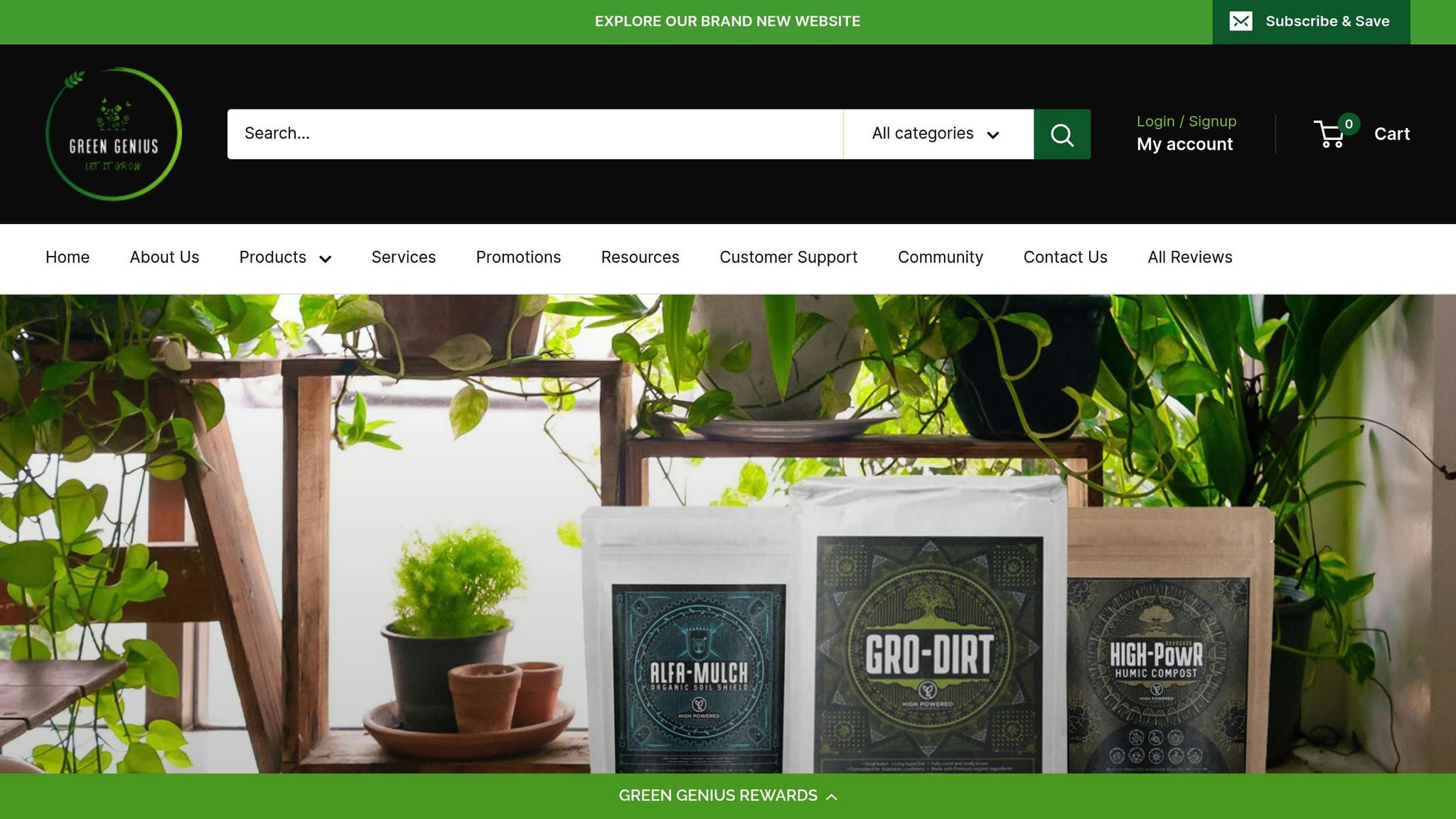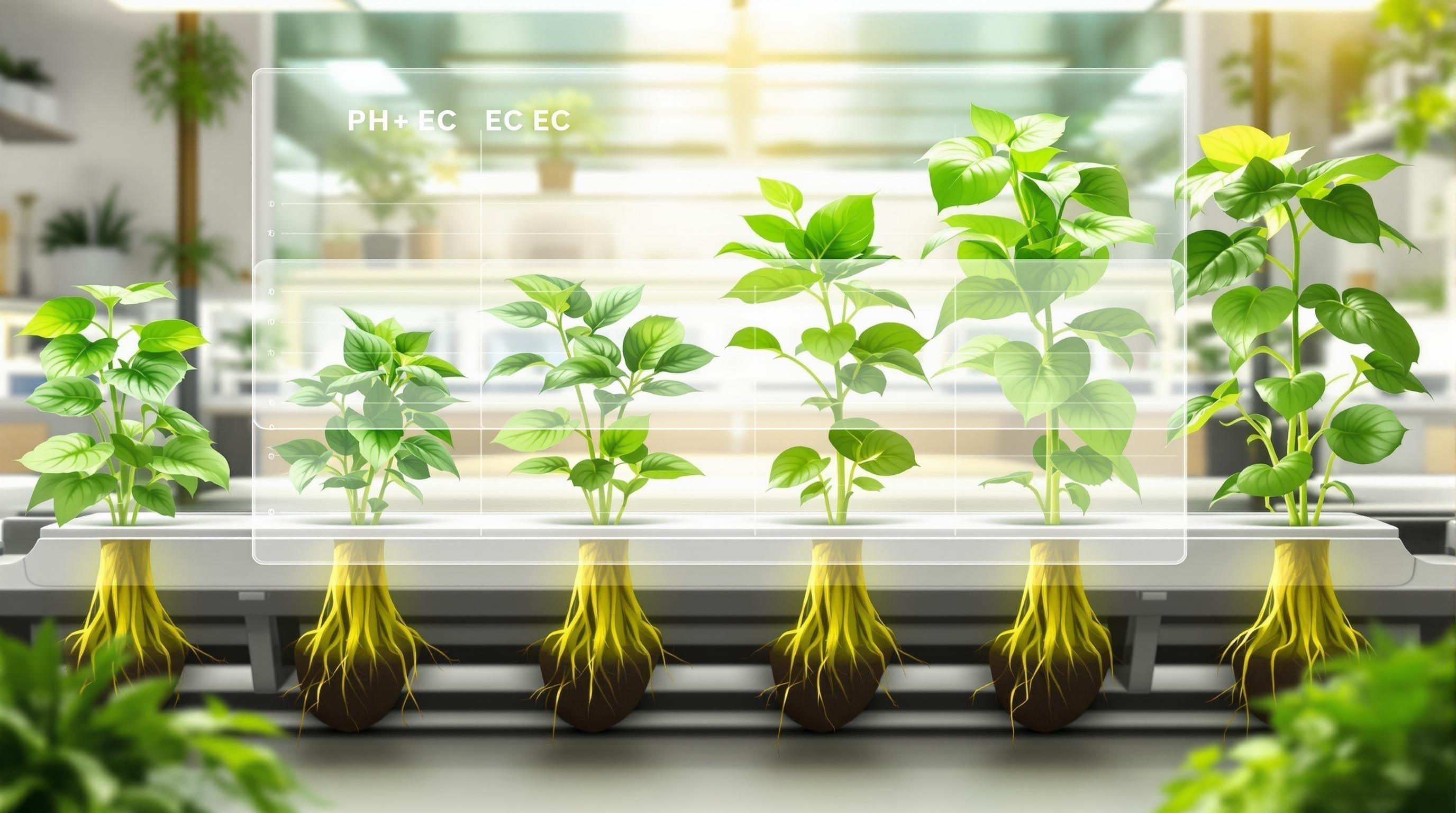Know Your pH and EC Levels by Growth Stage
Want to grow healthier plants in your hydroponic system? Proper pH and EC management is key. Here's what you need to know:
- pH: Keep it between 5.5–6.5 for optimal nutrient absorption.
-
EC: Adjust nutrient concentration based on growth stage:
- Seedlings: 0.8–1.2 mS/cm
- Vegetative: 1.2–1.8 mS/cm
- Flowering: 1.8–2.5 mS/cm
- Pre-Harvest: 1.0–1.5 mS/cm
Quick tips:
- Test daily and adjust gradually.
- Use quality tools like pH and EC meters.
- Keep a log for consistent results.
This guide explains how to measure, adjust, and maintain these levels for better yields. Let’s dive in!
Optimal Hydroponic pH and EC/PPM: Essential Tips
pH and EC Basics
Understanding pH and EC (Electrical Conductivity) is key to successful hydroponic growing. These measurements tell you about nutrient availability and concentration. Let’s break down each one.
pH Explained
Hydroponic plants thrive in slightly acidic conditions, ideally between pH 5.5 and 6.5. Going outside this range can limit how well plants absorb nutrients.
Here’s how pH levels affect nutrient uptake:
- Below 5.5: Calcium and magnesium become less available.
- Above 6.5: Iron, manganese, and phosphorus absorption decreases.
- Within 5.5–6.5: Nutrient availability is at its best for essential elements.
EC Explained
Electrical Conductivity (EC) measures the total dissolved salts in your nutrient solution, showing how concentrated the nutrients are. In Australia, EC is usually measured in millisiemens per centimetre (mS/cm) or microsiemens per centimetre (µS/cm).
Here are some typical EC readings:
- Pure water: 0.0 mS/cm
- Seedling nutrient solution: 0.8–1.2 mS/cm
- Mature plant nutrient solution: 1.2–2.4 mS/cm
Keeping EC levels accurate helps maintain a balanced nutrient solution for your plants.
What Changes pH and EC
Several environmental factors can impact the pH and EC of your nutrient solution. These include root zone temperature, humidity, the growing medium, and the plant’s size and growth stage.
| Factor | Effect on pH | Effect on EC |
|---|---|---|
| Plant uptake | Gradually increases as nutrients are absorbed | Decreases as plants consume nutrients |
| Water evaporation | Minimal effect | Increases as the solution becomes more concentrated |
| Temperature | Higher temperatures tend to lower pH | Can slightly increase EC readings |
| Fresh water top-ups | Can alter pH depending on water quality | Dilutes the solution, reducing EC |
Regular monitoring of pH and EC ensures your plants get the nutrients they need for healthy growth.
pH and EC for Each Growth Stage
Plants need specific pH and EC (electrical conductivity) levels at different stages of growth to absorb nutrients effectively. Here's a breakdown of the ideal ranges for each stage.
Seedling Stage
At this early stage, careful monitoring is essential:
- pH range: 5.5–6.0
- EC range: 0.8–1.2 mS/cm
Seedlings only need a small amount of nutrients as they begin forming their first roots and leaves.
Vegetative Stage
As plants grow, their nutrient needs increase:
- pH range: 5.8–6.2
- EC range: 1.2–1.8 mS/cm
This stage focuses on root expansion and canopy growth, requiring more nutrients to support the plant's structure and energy needs.
Flowering and Fruiting Stage
Nutrient demand peaks during this phase:
- pH range: 6.0–6.5
- EC range: 1.8–2.5 mS/cm
Plants need extra nutrients to support the development of flowers and fruits.
Pre-Harvest Stage
Reduce nutrient levels as harvest approaches:
- pH range: 6.0–6.5
- EC range: 1.0–1.5 mS/cm
Lowering the EC at this stage improves the flavour and quality of the crop while keeping the pH consistent with the flowering stage.
These ranges are a general guide. Always watch how your plants respond and adjust based on local conditions and specific requirements. Fine-tuning these levels can make a big difference as you approach harvest.
Testing and Fixing pH and EC
To ensure steady plant growth, keeping pH and EC levels in check is key. Regular testing and making precise adjustments help maintain the best conditions for your plants.
Testing Equipment
Here’s what you’ll need for accurate measurements:
- Digital pH meter: Choose a waterproof model with automatic temperature compensation (ATC).
- EC meter: Also known as a TDS or conductivity meter.
- Calibration solutions: Use pH 4.0 and 7.0 buffer solutions for accuracy.
- pH probe storage solution: Essential for maintaining your pH probe.
- Testing containers: Ensure they are clean and non-reactive.
Calibrate your meters weekly and store pH probes in the appropriate solution to keep them working properly.
pH Adjustment Steps
1. Test current levels
Take a 250 ml sample of your nutrient solution and test it with a calibrated pH meter. Allow about 30 seconds for the reading to settle.
2. Determine the adjustment
Check the difference between the current pH and the target pH for your plant's growth stage. Adjust in small steps of 0.2–0.3 to avoid overshooting.
3. Add pH adjusters
- To lower pH, use a phosphoric or citric acid-based pH down solution.
- To raise pH, add a potassium hydroxide-based pH up solution.
Stir thoroughly after each addition and retest.
EC Adjustment Steps
1. Measure baseline
Start by measuring the EC of plain water. In Australia, tap water usually falls between 0.2–0.5 mS/cm.
2. Adjust concentration
- To increase EC, add a balanced nutrient solution as per the manufacturer’s guidelines.
- To decrease EC, dilute the solution with plain water or replace part of it.
After making changes, wait 15 minutes before retesting.
3. Fine-tune levels
Make adjustments in small increments of 0.2–0.3 mS/cm. Stir thoroughly and retest before making additional changes.
Keep a log of all measurements and adjustments to monitor your nutrient management effectively.
Quick Reference Chart
How to Use This Chart
The chart below provides essential pH and EC values for each growth stage. Here's how to make the most of it:
- Check regularly: Measure levels at least twice a week.
- Follow previous adjustments: Use earlier steps as a guide.
- Consider your system: Adjust ranges based on factors like plant type, growing medium, and water quality.
- Observe your plants: Watch how they respond and tweak as needed.
Keep in mind that this guide is based on typical Australian conditions, including water quality and environmental factors.
Growth Stage Chart
| Growth Stage | pH Range | EC Range (mS/cm) | Notes |
|---|---|---|---|
| Germination/Seedling | 5.5-6.0 | 0.8-1.2 | Keeps delicate roots safe from nutrient burn. |
| Early Vegetative | 5.8-6.0 | 0.8-1.3 | Ideal for nitrogen uptake during early growth. |
| Late Vegetative | 5.6-5.9 | 1.3-1.7 | Supports rapid growth with increased nutrient demand. |
| Early Flowering | 5.5-5.8 | 1.6-2.0 | Meets higher phosphorus needs during flowering onset. |
| Peak Flowering | 5.4-5.7 | 1.8-2.2 | Ensures optimal nutrient absorption at this stage. |
| Late Flowering/Fruiting | 5.4-5.8 | 1.6-2.0 | Gradually lower EC as harvest nears. |
| Pre-Harvest | 5.5-6.0 | 1.2-1.6 | Reducing EC enhances flavour in the final phase. |
Important Notes:
- EC values include your base water EC.
- Assumes Australian tap water typically ranges from 0.2 to 0.5 mS/cm.
- Keep measurement conditions consistent to avoid temperature-related inaccuracies.
- For fruiting plants, drop EC by 0.2-0.3 mS/cm during the final ripening stage to improve quality.
Conclusion
Main Points
Maintaining the right pH and EC levels is essential for successful cultivation. Here’s a quick recap for managing nutrients effectively:
- Regular monitoring keeps plants healthy and supports steady growth.
- Adjusting levels based on growth stages ensures plants get the nutrients they need at the right time.
- Making gradual changes to pH and EC is safer than sudden shifts.
- Pre-harvest care plays a big role in determining crop quality and flavour.
Following these practices helps you manage nutrients with precision and care.
Green Genius Tools

Green Genius offers a range of tools to help you manage nutrients with ease:
- Testing Equipment: High-quality pH and EC monitors for accurate readings.
- Nutrient Systems: Formulations tailored to each growth stage for better results.
- Expert Consultation: Personalised advice for your hydroponic setup.
- Eco-Friendly Solutions: Products designed to adjust pH and EC with minimal environmental impact.
Green Genius emphasises the use of reliable, laboratory-grade tools and regular calibration to achieve the best outcomes. Their hydroponic systems make nutrient management easier while supporting sustainable practices. Whether you're new to hydroponics or scaling up, their expert advice can help you create a monitoring routine that fits your needs perfectly.
Related posts
- 8 Common Hydroponic Growing Mistakes and Solutions
- Common Hydroponic pH Problems: Expert Solutions
- Ultimate Guide to EC Monitoring in Hydroponics
- Checklist for Maintaining pH and EC in Hydroponics

